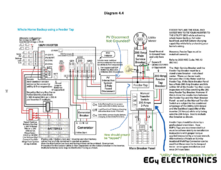dansolar
New Member
Hello! I have been researching installing a hybrid grid-tied solar power system with an EG4 18KPV Hybrid Inverter and (2) EG4 Wall batteries. In my research, I was reviewing the wiring diagrams provided by EG4 (specifically Diagram 4.4, "Whole Home Backup using a Feeder Tap", from the 18KPV manual). There were a few things that didn't quite make sense to me and I wanted to clarify why the instructions indicate this wiring.


- When connecting the 18KPV to the grid, the diagram shows no ground run between the feeder tap, the "PV Interactive System Fused Disconnect", and the 18KPV. Is this correct? I see how the 18KPV would still be grounded from the Feeder Tap > Feeder Tap Breaker > Manual Transfer Switch, but this appears to leave the "PV Interactive Disconnect" completely ungrounded.
- For the Manual Transfer Switch, on the "Only Utility" side, it appears that the Neutral wire bypasses the Transfer Switch and directly connects to the Main Breaker Panel. Is this to ensure that the Main Breaker Panel always has access to Neutral? (On that note, the diagram also shows a Ground connection between the Feeder Tap and the Transfer Switch in addition to the ground connection from the 18KPV and Feeder Tap Breaker, is this necessary?)
- Finally, what is the recommend method for "tapping" the ground wire in the Feeder Tap? EG4 recommends using Ilsco KUP-L taps for L1, L2, and Neutral, but it's unclear how Ground should be handled. (I'm also assuming these taps would take place in an electrical wiring trough between the Service Breaker and Feeder Tap Breaker / PV Fused Disconnect.)



